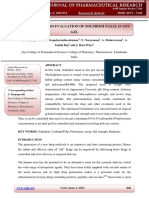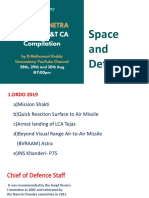0 ratings0% found this document useful (0 votes)
51 viewsUnit-4 HDT Presentation
Unit-4 HDT Presentation
Uploaded by
Tejsingh BhatiCopyright:
© All Rights Reserved
Available Formats
Download as ODP, PDF, TXT or read online from Scribd
Unit-4 HDT Presentation
Unit-4 HDT Presentation
Uploaded by
Tejsingh Bhati0 ratings0% found this document useful (0 votes)
51 views8 pagesCopyright
© © All Rights Reserved
Available Formats
ODP, PDF, TXT or read online from Scribd
Share this document
Did you find this document useful?
Is this content inappropriate?
Copyright:
© All Rights Reserved
Available Formats
Download as ODP, PDF, TXT or read online from Scribd
Download as odp, pdf, or txt
0 ratings0% found this document useful (0 votes)
51 views8 pagesUnit-4 HDT Presentation
Unit-4 HDT Presentation
Uploaded by
Tejsingh BhatiCopyright:
© All Rights Reserved
Available Formats
Download as ODP, PDF, TXT or read online from Scribd
Download as odp, pdf, or txt
You are on page 1of 8
Evaluation of drugs, WHO and
ICH guidelines for assessment
for herbal drugs stability.
Class : T.Y.B.Pharm
By : Rajani Bhati
Subject : Herbal Drug Technology
Guided by: Dr. (Mrs.) Shubhangi Pharande
CONTENT
ØIntroduction
ØEvaluation methods
• Organoleptic evaluation
• Microscopic evaluation
• Physical evaluation
• Chemical evaluation
• Biological evaluation
ØWHO and ICH guidelines for the assessment of herbal drugs
ØStability testing of herbal drugs
ØReference
•
INTRODUCTION
• Evaluation of a drug means confirmation of its identity and
determination of its quality and purity and detection of nature of
adulteration.
• The evaluation of crude drugs is necessary because of :
1) Biochemical variation
2) Deterioration due to treatment and storage
3) Substitution and adulteration due to carelessness, ignorance
• The crude drugs can be identified on the basis of their morphological,
histological, chemical, physical and biological studies.
Evaluation methods of drugs
• a crude drug can be evaluated by following 5 methods :
1) Organoleptic evaluation : it means study of drug using organ senses. It refers
to the methods of analysis like colour, odour, taste, size, shape and
special features , such as touch, texture. The study of form of a crude
drug is morphology while description of the form is morphography.
Ex. : fractured surfaces in cinchona, cascara barks ; odour and taste of spice-
drugs like black pepper, cumin, asafoetida.
2) Microscopic evaluation : this methos allows detailed examination of a drug
and it can be used to identify then organised drugs by their known histological
characters. Structural details of the drugs from plant origin are confirmed by
using various reagents or stains which distinguishes cellular structures.
Ex. : determination of leaf constants, presences of calcium oxalate crystals or
sclereids or the type of trichomes present .
3) Chemical evaluation : The chemical evaluation includes qualitative chemical tests,
quantitative chemical tests, chemical assays and instrumental analysis. The isolation,
purification and identification of active constituents are chemical methods of evaluation.
Qualitative chemical tests include identification tests for various phytoconstituents like
alkaloids, glycosides, tannins, etc.
Ex. : Quantitative chemical tests such as acid value, saponification value, etc; chemical
assay include assays for alkaloid, resin, volatile oils, etc .
4) Physical evaluation : Physical standards are to be determined for the drugs, wherever
possible. These are rarely constant for crude drugs, but may help in evaluation, specifically
with reference to moisture content, specific gravity, density, optical rotation, refractive
index, melting point, viscosity, and solubility in different solvents.
Ex. : moisture content for digitalis and ergot should NMT 5% w/w ; M.P. of beeswax- 62-
65%, etc.
5) Biological evaluation : this method is generally used when standardization is not
adequately done by chemical or physical means and also for conformity of therapeutic
activity of raw material and finished product. This evaluation is performed using whole
animals, animal preparations, isolated living tissues or microorgnisms.
WHO Guidelines
• World health organization (WHO) is a specialized agency of the untied nations
responsible for internation public health and its headquarter is in Geneva,
Switzerland and was established on 7th April, 1948.
• The first ever director general of WHO after its establishment was G. Brock
Chisholm and Andrija Stampar was the assembly’s first president . The
present director head of WHO is Tedros Adhanom Ghebreyesus.
• The WHO country office in india is headquartered in Delhi with country-wide
presence.
•
References
• https://jiwaji.edu/pdf/ecourse/pharmaceutical/Evaluation%20of
%20crude%20drugs.pdf
You might also like
- Q-Asc: Section A - PlayDocument6 pagesQ-Asc: Section A - PlayGemaAspergerAsturias0% (1)
- Mavoko Water and Sewerage Co. LTDDocument1 pageMavoko Water and Sewerage Co. LTDAtito OnyxNo ratings yet
- Stability Study Guidance ProtocolDocument10 pagesStability Study Guidance ProtocolManish shankarpure100% (2)
- WHO Guidelines For Quality Standardized Herbal FormulationsDocument4 pagesWHO Guidelines For Quality Standardized Herbal FormulationstarkeesantoshNo ratings yet
- Evaluation of Crude DrugsDocument24 pagesEvaluation of Crude DrugsRojaNo ratings yet
- Identification, Evaluation & Standardization of Herbal Drugs-Review PDFDocument14 pagesIdentification, Evaluation & Standardization of Herbal Drugs-Review PDFAhmad Daud OmNo ratings yet
- Gujarat Technological University: B.Pharm Semester: IiiDocument2 pagesGujarat Technological University: B.Pharm Semester: IiiSachin Narkhede100% (2)
- Bioassay: Satish Kumar.J PH.D Student Mysore UniversityDocument21 pagesBioassay: Satish Kumar.J PH.D Student Mysore UniversityaziskfNo ratings yet
- CULTIVATION, COLLECTION, PROCESSING AND STORAGE OF CRUDE DRUGS OF NATURAL ORIGIN-converted-1Document9 pagesCULTIVATION, COLLECTION, PROCESSING AND STORAGE OF CRUDE DRUGS OF NATURAL ORIGIN-converted-1AMINA FAREEZANo ratings yet
- Unit-3 HDTDocument15 pagesUnit-3 HDTAbhishek BhosaleNo ratings yet
- Regulatory IssuesDocument19 pagesRegulatory IssuesSiddhant BanwatNo ratings yet
- 2 FormulationDocument10 pages2 FormulationNguyen HungNo ratings yet
- Exp. 11 Skin Irritation StudyDocument5 pagesExp. 11 Skin Irritation StudyTejas ShirsathNo ratings yet
- Study of Method of Section Cutting TechniqueDocument18 pagesStudy of Method of Section Cutting Techniquezero contentNo ratings yet
- REPORT 8th SEMDocument39 pagesREPORT 8th SEMDIPENDRASINH SOLANKINo ratings yet
- Formulation and Evaluation of Zolpidem Nasal in SituDocument12 pagesFormulation and Evaluation of Zolpidem Nasal in SituGopalasatheeskumar KNo ratings yet
- Foreign Organic MatterDocument15 pagesForeign Organic MatterSunitha Katta100% (1)
- Mosquito Repellent by Orange PeelsDocument5 pagesMosquito Repellent by Orange PeelsBruh100% (1)
- Practical Pharmacognosy: Second YearDocument47 pagesPractical Pharmacognosy: Second YearRama ChinniNo ratings yet
- Bio AssayDocument20 pagesBio AssayNeha Tiwari100% (2)
- GIT DrugsDocument57 pagesGIT Drugssalva sambaaNo ratings yet
- Blood Product and Plasma SubstituentsDocument14 pagesBlood Product and Plasma SubstituentsDivya KMNo ratings yet
- Flame PhotometryDocument7 pagesFlame PhotometryArtemis ZNo ratings yet
- IJCRT2202359Document10 pagesIJCRT2202359Jhaira Mae Heriz M. BuñoNo ratings yet
- Pharmaceutical Aerosol: Amit M. GuptaDocument29 pagesPharmaceutical Aerosol: Amit M. GuptajaysakariaNo ratings yet
- Absorption of Drug From Non-Per Oral RoutesDocument32 pagesAbsorption of Drug From Non-Per Oral Routesumamaheshwari33No ratings yet
- Crude DrugsDocument73 pagesCrude DrugsMuzahidul IslamNo ratings yet
- Regulatory Provisions-Aisha SeminarDocument16 pagesRegulatory Provisions-Aisha SeminarbikramNo ratings yet
- Novel Drug Delivery Systems Unit 5Document17 pagesNovel Drug Delivery Systems Unit 5blackbuddy017No ratings yet
- Poison Act 1919 by NaeemDocument3 pagesPoison Act 1919 by NaeemRphNaeemMalikNo ratings yet
- Cognosy Lab Mannual 2011-2012Document114 pagesCognosy Lab Mannual 2011-2012Harish KakraniNo ratings yet
- Factors Affecting Dissolution RateDocument7 pagesFactors Affecting Dissolution RateJubayer Al MahmudNo ratings yet
- 1 - 2 Introduction of Phytochemisry IDocument20 pages1 - 2 Introduction of Phytochemisry IZNA EntertainmentNo ratings yet
- Anti-Infective AgentsDocument7 pagesAnti-Infective AgentsAlyssaGrandeMontimor100% (1)
- Isolation Identification and Analysis of PhytoconstituentsDocument30 pagesIsolation Identification and Analysis of PhytoconstituentsMurugan MNo ratings yet
- CHAPTER 2-The Language of MedicineDocument9 pagesCHAPTER 2-The Language of Medicineeddy surielNo ratings yet
- Microbiological Assay KDBDocument11 pagesMicrobiological Assay KDBKiran0% (1)
- Phytochemical Screening of Coriander Sativum LinnDocument5 pagesPhytochemical Screening of Coriander Sativum LinnMusfira Dewy SuardiNo ratings yet
- Different SpeciesDocument16 pagesDifferent SpeciesArchana Pawar0% (1)
- Standardization of Herbal ProductsDocument54 pagesStandardization of Herbal ProductsSachinSuryavanshiNo ratings yet
- Hard Gelatin CapsulesDocument58 pagesHard Gelatin Capsulesas.jessy0608No ratings yet
- Amity Institute of Pharmacy: B. Pharm., Semester One Pharmacy Dr. Pawan Kumar PorwalDocument26 pagesAmity Institute of Pharmacy: B. Pharm., Semester One Pharmacy Dr. Pawan Kumar Porwalpawankumar gupta0% (1)
- Factors in Quality of Crude DrugsDocument13 pagesFactors in Quality of Crude DrugsMohan Chaudhary100% (3)
- Formulation and Evaluation of Chewable Multivitamin Tablet: Original ArticleDocument4 pagesFormulation and Evaluation of Chewable Multivitamin Tablet: Original Articlesacharum zhafirohNo ratings yet
- Brainware University: (BP501T) Class Notes (Medicinal Chemistry-II Theory)Document6 pagesBrainware University: (BP501T) Class Notes (Medicinal Chemistry-II Theory)Mriganka KarmakarNo ratings yet
- Gastroretentive Drug Delivery Systems (GRDDSS) PDF-minDocument26 pagesGastroretentive Drug Delivery Systems (GRDDSS) PDF-minsuhaila bakhtanNo ratings yet
- Test For Carbohydrates & ProteinsDocument17 pagesTest For Carbohydrates & ProteinsDat DanidNo ratings yet
- Lect 5 Inulin & DextrinDocument5 pagesLect 5 Inulin & Dextrinahsanonweb1983100% (1)
- Unit 5 MicrobiologyDocument66 pagesUnit 5 Microbiologykrishkodal0020No ratings yet
- Lecturer Department of Pharmacy Practice SRM College of PharmacyDocument12 pagesLecturer Department of Pharmacy Practice SRM College of PharmacyRobert Selvin MNo ratings yet
- Herbal Drug Technology Typed - 1Document7 pagesHerbal Drug Technology Typed - 1Sri SriNo ratings yet
- Biphasic Dosage FormsDocument5 pagesBiphasic Dosage Formslitha100% (1)
- Solid Dosage Form Part 1Document48 pagesSolid Dosage Form Part 1Claire Marie AlvaranNo ratings yet
- Formulation and Evaluation of Antibacterial, Antifungal Cream of Garlic OilDocument4 pagesFormulation and Evaluation of Antibacterial, Antifungal Cream of Garlic OilEditor IJTSRDNo ratings yet
- All Synthesis of Medichem-3 For 6th Semester of B.pharmaDocument18 pagesAll Synthesis of Medichem-3 For 6th Semester of B.pharmaTechnical PharmaNo ratings yet
- Bathukamma - The Flowers Festival of Telangana ArticleDocument4 pagesBathukamma - The Flowers Festival of Telangana ArticleRam Ram100% (1)
- Microbiological Assay of Antibiotics: Roll: 06, Semester:7thDocument17 pagesMicrobiological Assay of Antibiotics: Roll: 06, Semester:7thBilal AbbasNo ratings yet
- To Study The Equipments Used For Isolated and Persfused Frog Heart and Ileum in Experimental PharmacologyDocument11 pagesTo Study The Equipments Used For Isolated and Persfused Frog Heart and Ileum in Experimental PharmacologyBvayNo ratings yet
- Analytical Method Development and Validation of Minoxidil in Pharmaceutical Dosage Forms by UV SpectrophotometryDocument4 pagesAnalytical Method Development and Validation of Minoxidil in Pharmaceutical Dosage Forms by UV SpectrophotometryBil Sonador100% (1)
- Sterile Products & ParenteralsDocument41 pagesSterile Products & ParenteralsRonit PoudelNo ratings yet
- Call For PHD and Masters Scholarship Applications, ATRAP IIDocument5 pagesCall For PHD and Masters Scholarship Applications, ATRAP IIKiggundu Shamim LeilahNo ratings yet
- Community OrganizationDocument8 pagesCommunity Organizationantony.barazaNo ratings yet
- Respiratory System ExaminationDocument12 pagesRespiratory System ExaminationHoussemNo ratings yet
- Housekeeping Inspection ChecklistDocument3 pagesHousekeeping Inspection Checklisthaval.khalil98No ratings yet
- Fahima Hoque EtiDocument25 pagesFahima Hoque EtiCdc CtgNo ratings yet
- IkigaiDocument3 pagesIkigaiHamno MhamadNo ratings yet
- Argumentative Essay - Mental HealthDocument4 pagesArgumentative Essay - Mental HealthNuurul Athiyyah100% (1)
- OVCMIS Form 004a: OVC Tally Sheet: Objective: To Record Numbers of OVC and OVC Households Provided ServicesDocument5 pagesOVCMIS Form 004a: OVC Tally Sheet: Objective: To Record Numbers of OVC and OVC Households Provided ServicesPeter Claver mutimbaNo ratings yet
- Managing People BMG735Document29 pagesManaging People BMG735Ghazaal HassanzadehNiriNo ratings yet
- Week 7Document2 pagesWeek 7Maricris Lacwasan100% (1)
- OMBC 204 Unit 1 - 13 Self Assessment MCQsDocument39 pagesOMBC 204 Unit 1 - 13 Self Assessment MCQsPriyanka MahajanNo ratings yet
- Orthodotic ContractDocument2 pagesOrthodotic ContractCristine Edam SaretNo ratings yet
- The Coven of RavenloftDocument4 pagesThe Coven of RavenloftApple100% (1)
- Vishaka & Ors Vs State of Rajasthan & Ors On 13 August, 1997Document12 pagesVishaka & Ors Vs State of Rajasthan & Ors On 13 August, 1997Arulmozhi RameshNo ratings yet
- S&T Revision Notes PDFDocument475 pagesS&T Revision Notes PDFSai GaneshNo ratings yet
- Depsolube Aca-Lq - (TH) PTT0397 GHS MSDSDocument10 pagesDepsolube Aca-Lq - (TH) PTT0397 GHS MSDSMayank DhawanNo ratings yet
- Forget The Argument From Efficiency by Stefan Molyneux-4Document4 pagesForget The Argument From Efficiency by Stefan Molyneux-4eyalNo ratings yet
- Flores v. GarlandDocument276 pagesFlores v. GarlandThe Western JournalNo ratings yet
- Puerperium NotesDocument5 pagesPuerperium NotesCzarina Mae Quinones TadeoNo ratings yet
- CFBI Guidance FinalDocument22 pagesCFBI Guidance FinalFlorean SergiuNo ratings yet
- Chemicalpeel (Deep, Medium, Light) : Sidney J. Starkman,, Devinder S. MangatDocument13 pagesChemicalpeel (Deep, Medium, Light) : Sidney J. Starkman,, Devinder S. Mangatchipanze100% (1)
- Skill Matrix DETAILED Know Industrial EngineeringDocument4 pagesSkill Matrix DETAILED Know Industrial EngineeringHatem HusseinNo ratings yet
- STOCK BARU2Document48 pagesSTOCK BARU2Icha YusikaNo ratings yet
- Radicular CystDocument45 pagesRadicular CystPriyanka GanesanNo ratings yet
- Intimacy Disorders and Sexual Panic StatesDocument11 pagesIntimacy Disorders and Sexual Panic StatesAna Carol MoszkowiczNo ratings yet
- Graduation Emcee Script 2020-2021Document2 pagesGraduation Emcee Script 2020-2021Apple Biacon-CahanapNo ratings yet
- TOC Case History For A AoADocument4 pagesTOC Case History For A AoAzubair.19cbaNo ratings yet

























































































